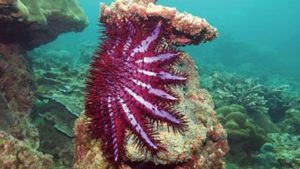
Australian scientists have got success in sequencing the DNA of invasive, reef-eating crown-of-thorns starfish (COTS), suggesting that is possible to remove these marine creatures from a specific spot in the ocean by luring them by the lust.
COTS is one of the major factors in destruction of Australia’s Great Barrier Reef. These starfish eat corals and can immensely destroy a reef when their numbers explode. According to researchers, a single COTS female can produce up to 120 million offspring in one spawning season.
“The crown-of-thorns starfish (COTS, the Acanthaster planci species group) is a highly fecund predator of reef-building corals throughout the Indo-Pacific region. COTS population outbreaks cause substantial loss of coral cover, diminishing the integrity and resilience of reef ecosystems,” state authors in their study.
In the past, researchers tried a variety of methods to limit the destruction caused by these creatures to the Great Barrier Reef, but have got little success in their endeavor. This time, however, they have got success in sequencing the genome of these starfish to identify proteins that starfish used to communicate with each other and gather at one spot.
“Here we sequenced genomes of COTS from the Great Barrier Reef, Australia and Okinawa, Japan to identify gene products that underlie species-specific communication and could potentially be used in biocontrol strategies,” study authors reveal.
“For an already struggling Great Barrier Reef, and indeed any reefs across the Indo-Pacific region, these starfish pose an enormous threat due to the ability of a single female to produce up to 120 million offspring in one spawning season,” said Professor Bernard Degnan from the University of Queensland, who led the research.
“They feast on the coral and leave it bleached white and vulnerable to destruction in heavy storms.”
The researchers reveled that crown-of-thorns starfish secrete pheromones to communicate the message that they want to reproduce. The scent has now been decoded by researchers, who think it would now be possible to recreate this scent to create traps to efficiently remove these starfish from specific spots in the ocean.
“Now we’ve found the genes the starfish use to communicate, we can begin fabricating environmentally-safe baits that trick them into gathering in one place, making it easier to remove reproductively-primed animals,” says Degnan.
The team also thinks that this approach could also be used to restrict other invasive species, for example sea snails, in other parts of the world.
The detailed findings of the study have been published in the journal Nature.
